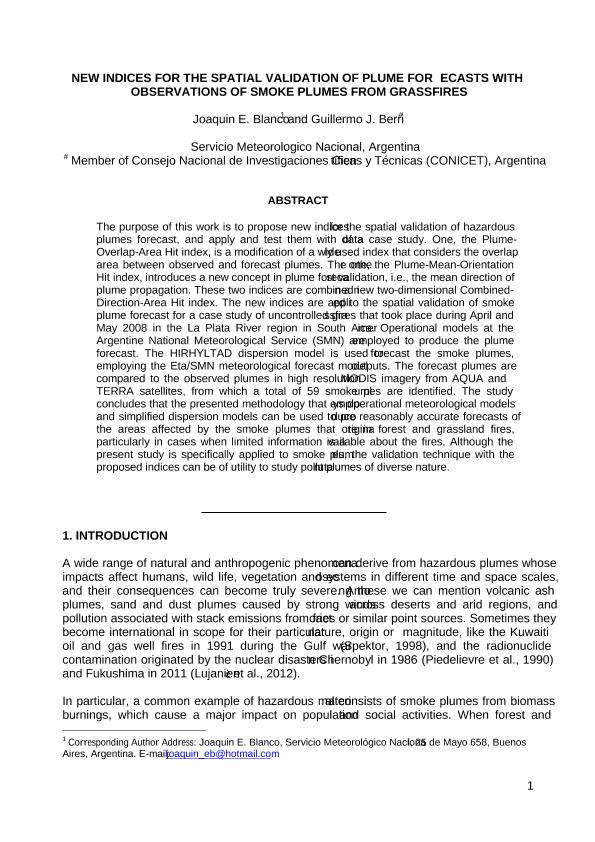Mostrar el registro sencillo del ítem
dc.contributor.author
Blanco, Joaquin Esteban
dc.contributor.author
Berri, Guillermo Jorge

dc.date.available
2016-01-20T20:23:10Z
dc.date.issued
2013-03
dc.identifier.citation
Blanco, Joaquin Esteban; Berri, Guillermo Jorge; New indices for the spatial validation of plume forecasts with observations of smoke plumes from grassfires; Elsevier; Atmospheric Environment; 67; 3-2013; 313-322
dc.identifier.issn
1352-2310
dc.identifier.uri
http://hdl.handle.net/11336/3708
dc.description.abstract
The purpose of this work is to propose new indices for the spatial validation of hazardous plumes forecast, and apply and test them with data of a case study. One, the Plume-Overlap-Area Hit index, is a modification of a widely used index that considers the overlap area between observed and forecast plumes. The other one, the Plume-Mean-Orientation Hit index, introduces a new concept in plume forecast validation, i.e., the mean direction of plume propagation. These two indices are combined in a new two-dimensional Combined-Direction-Area Hit index. The new indices are applied to the spatial validation of smoke plume forecast for a case study of uncontrolled grassfires that took place during April and May 2008 in the La Plata River region in South America. Operational models at the Argentine National Meteorological Service (SMN) are employed to produce the plume forecast. The HIRHYLTAD dispersion model is used to forecast the smoke plumes, employing the Eta/SMN meteorological forecast model outputs. The forecast plumes are compared to the observed plumes in high-resolution MODIS imagery from AQUA and TERRA satellites, from which a total of 59 smoke plumes are identified. The study concludes that the presented methodology that employs operational meteorological models and simplified dispersion models can be used to produce reasonably accurate forecasts of the areas affected by the smoke plumes that originate in forest and grassland fires, particularly in cases when limited information is available about the fires. Although the present study is specifically applied to smoke plumes, the validation technique with the proposed indices can be of utility to study pollutant plumes of diverse nature.
dc.format
application/pdf
dc.language.iso
eng
dc.publisher
Elsevier

dc.rights
info:eu-repo/semantics/openAccess
dc.rights.uri
https://creativecommons.org/licenses/by-nc-nd/2.5/ar/
dc.subject
Smoke Plumes
dc.subject
Numerical Modeling
dc.subject
Forecast Validation
dc.subject
Case Study
dc.subject
Validation Index
dc.subject
Dispersion Model
dc.subject.classification
Meteorología y Ciencias Atmosféricas

dc.subject.classification
Ciencias de la Tierra y relacionadas con el Medio Ambiente

dc.subject.classification
CIENCIAS NATURALES Y EXACTAS

dc.title
New indices for the spatial validation of plume forecasts with observations of smoke plumes from grassfires
dc.type
info:eu-repo/semantics/article
dc.type
info:ar-repo/semantics/artículo
dc.type
info:eu-repo/semantics/publishedVersion
dc.date.updated
2016-03-30 10:35:44.97925-03
dc.journal.volume
67
dc.journal.pagination
313-322
dc.journal.pais
Países Bajos

dc.journal.ciudad
Amsterdam
dc.description.fil
Fil: Blanco, Joaquin Esteban. Ministerio de Defensa. Secretaria de Planeamiento. Servicio Meteorológico Nacional; Argentina
dc.description.fil
Fil: Berri, Guillermo Jorge. Ministerio de Defensa. Secretaria de Planeamiento. Servicio Meteorológico Nacional; Argentina. Consejo Nacional de Investigaciones Científicas y Técnicas; Argentina
dc.journal.title
Atmospheric Environment

dc.relation.alternativeid
info:eu-repo/semantics/altIdentifier/url/http://www.sciencedirect.com/science/article/pii/S1352231012010436
dc.relation.alternativeid
info:eu-repo/semantics/altIdentifier/issn/1352-2310
dc.relation.alternativeid
info:eu-repo/semantics/altIdentifier/doi/http://dx.doi.org/10.1016/j.atmosenv.2012.10.061
Archivos asociados
